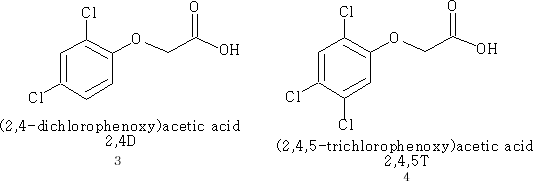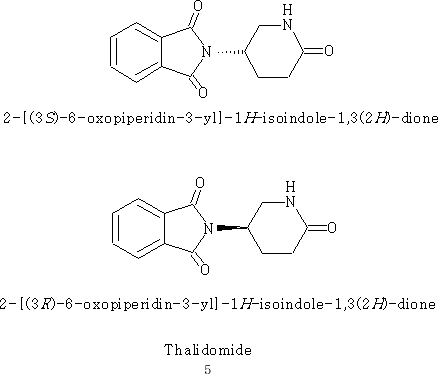Agent Orange 1 is the code name for a powerful herbicide and defoliant used by the U.S. military in its Herbicidal Warfare program during the Vietnam War. An estimated 80,000 m³ of this agent was deployed in South Vietnam

Agent Orange consisted of a 50:50 mixture of 2, 4 D and 2, 4, 5 T. (see structures {3&4}) and its usage from 1961 to 1971 was by far the most used of the so-called "Rainbow Herbicides". Breakdown of Agent Orange (as well as Agents Purple, Pink, and Green) released dioxins, (which were a contaminant of these compounds) and it is the dioxins which have caused the health problems for those exposed during the Vietnam War. Agents Blue and White were part of the same program but did not produce dioxins.
Agent Orange has been a contentious issue right up to the present day; lawyers are still dealing with cases in many countries.
Thalidomide is racemic {5} – it contains both left and right handed isomers in equal amounts. The (R) enantiomer is effective against morning sickness. The (S) is teratogenic and causes birth defects. The enantiomers can interconvert in vivo – that is, if a human is given pure (R)-thalidomide or (S)-thalidomide, both isomers can be found in the blood – therefore, administering only one enantiomer will not prevent the teratogenic effect. The mechanism of its biological action is under debate, the current thinking suggests that it inserts itself (intercalation) into the DNA into the G-C rich areas.
Soon after its disuse, an Israeli doctor discovered anti-inflammatory effects of thalidomide and began to look for uses of the medication despite its teratogenic effects. On July 16, 1998, the FDA approved the use of thalidomide for the treatment of lesions associated with erythema nodosum leprosum (Leprosy), but because of thalidomide's potential for causing birth defects, the distribution of thalidomide was permitted only under tightly controlled conditions. Thalidomide has had a revival of interest, and researchers, continue to work with the drug.

Today organic compounds available come from many sources, essential oils from plants, chemicals from oil and coal. Many millions of compounds have been made; they come in all sizes, shapes and colours.
We could spend an enormous amount of time on the important discoveries that have happened since these days, but my space is limited.